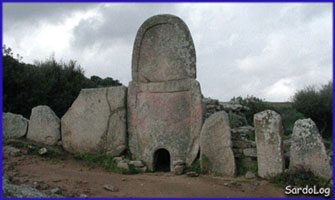
In
front of the tomb, on each side of the great stele, semi-circular
rows of standing stones surround a ceremonial area. Rituals are still
practiced there :
laying for 5 days and 5 nights, the initiate experiences states of
modified consciousness and might receive propitiatory or curative
messages. |
Tomb of Giants
at Coddu Vecchiu
Sardinian
folks call Tombs of Giants the burial monuments left by their prehistoric
ancestors.
This one is of the very few still showing their typical thin blade
of stone, some 15 feet high, embossed along its curved outlines
and pierced at the base by a small opening through which offerings
could be made.
The monolith irresistibly evokes a door, opened or closed on afterlife.
The tomb itself is a low corridor recalling the continental "covered
alleys".
|

![]()

![]()

![]()

![]()
